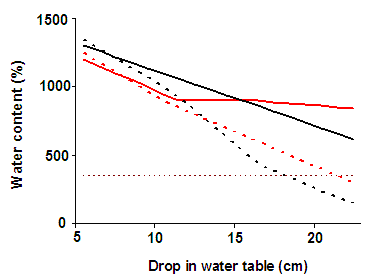Case StudiesSphagnum and the water tableIn a Sphagnum wetland the capitula that are exposed to the air may lose water through evaporation. The capitula need water for photosynthesis and this may come from rain or from the water body below. Water from below moves up via capillary action since Sphagnum lacks internal water-conducting tissue. The species of Sphagnum vary in their ability to convey water by capillary action. The vertical axis in the following graph shows the water content in the capitula of four Northern Hemisphere Sphagnum species as the water table is experimentally lowered from 5 to 22 centimetres below the Sphagnum surface. The four species are Sphagnum fuscum (solid red line), Sphagnum rubellum (solid black line), Sphagnum balticum (broken red line) and Sphagnum tenellum (broken black line). The horizontal, dotted line shows the approximate water content needed for Sphagnum to maintain 50% of the maximum photosynthetic rate.
From the graph you can see that Sphagnum balticum, and Sphagnum tenellum even more so, cannot tolerate a drop in water levels as easily as can the other two species. A Sphagnum community need not grow as an even-surfaced carpet. Often it will be an undulating surface with distinct hummocks and hollows. The plants growing in the hummocks are further above the water table than those growing in the hollows. Looking at the four species mentioned above you'd be more likely to find Sphagnum fuscum and Sphagnum rubellum as hummock plants. However, seemingly surprising sights do present themselves. For example, isolated Sphagnum balticum plants have been found growing in hummocks of Sphagnum fuscum, in locations where the former species could not bring up sufficient water from the underlying water table. Careful study has shown that in the hummocks the Sphagnum balticum plants get their water by short-distance capillary action from the surrounding Sphagnum fuscum plants. In this way a number of Sphagnum balticum plants could grow in a hummock, but not in too great a concentration Reference
|
![An Australian Government Initiative [logo]](/images/austgovt_brown_90px.gif)


